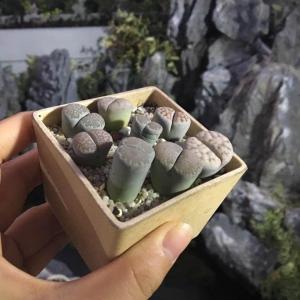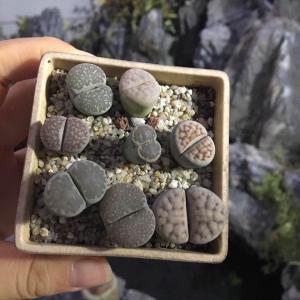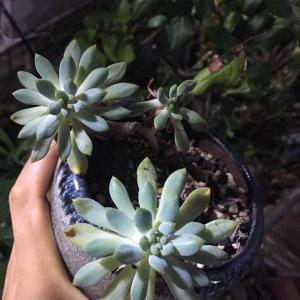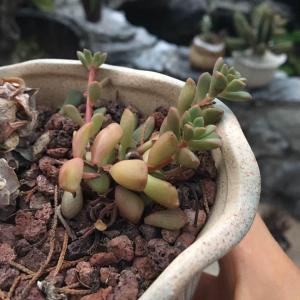🦄Nana🌸
2017年09月09日

10月9日种的小多肉们 上盆步骤:这个详情
1.种下3天后再浇水,浇湿土壤表面即可(刚种下浇太多水根系也吸收不了营养,长时间水份得不挥发很容易烂根)
2.后期浇水是土壤干透再浇透,不干透不浇(浇透为指的是浇至底部排水孔流水为止,夏天浇水最好的时间段为傍晚和晚上,冬天则为白天浇水最好)
3、正常浇透一次大概需要10-15天左右会干透(具体看各地气候和土壤保水性,如果光照不足阴雨天则更需拉长浇水间隔)
Ps:如果不懂得土是否干透了,在土内插一支牙签,2小时后拔出没有水汽现象就干透了,这样重复几次,自然也可以掌握浇水的规律和时间,以后没有竹签也不担心了。
日照问题:
多肉基本上都是喜阳的,它们都符合一个原则,越晒越美丽(温差大的环境里)平均日照时间超过5小时最佳(夏天避免暴晒)
1.已进入秋冬天了(28度以下的温度)是可以全日照的。
2.夏天尽量避免暴晒(避免晒大中午的日照或者可以晒下午4点以后的阳光,然后足部增强光照)服盆之后春秋冬季就尽量多晒!!



1.种下3天后再浇水,浇湿土壤表面即可(刚种下浇太多水根系也吸收不了营养,长时间水份得不挥发很容易烂根)
2.后期浇水是土壤干透再浇透,不干透不浇(浇透为指的是浇至底部排水孔流水为止,夏天浇水最好的时间段为傍晚和晚上,冬天则为白天浇水最好)
3、正常浇透一次大概需要10-15天左右会干透(具体看各地气候和土壤保水性,如果光照不足阴雨天则更需拉长浇水间隔)
Ps:如果不懂得土是否干透了,在土内插一支牙签,2小时后拔出没有水汽现象就干透了,这样重复几次,自然也可以掌握浇水的规律和时间,以后没有竹签也不担心了。
日照问题:
多肉基本上都是喜阳的,它们都符合一个原则,越晒越美丽(温差大的环境里)平均日照时间超过5小时最佳(夏天避免暴晒)
1.已进入秋冬天了(28度以下的温度)是可以全日照的。
2.夏天尽量避免暴晒(避免晒大中午的日照或者可以晒下午4点以后的阳光,然后足部增强光照)服盆之后春秋冬季就尽量多晒!!



0
0
文章
Dummer. ゛☀
2017年09月03日

The Canary Island date palm (Phoenix canariensis) is a beautiful tree, native to the warm Canary Islands. You can consider planting a Canary Island date palm outdoors in U.S. Department of Agriculture plant hardiness zones 9 through 11, or indoors in a container anywhere. With its shiny, feathery fronds, arching branches and ornamental fruit, this tree is not of the low-maintenance school. You’ll want to read up on care of Canary Island palm trees to be sure the plant stays healthy and happy.
Information on Canary Date Palms
If you are dreaming of Canary palm trees growing in your backyard, you’ll need lots of room. Information on Canary date palms lists these trees as growing up to 65 feet tall with a potential spread of 40 feet. However, planting a Canary Island date palm is not entirely out of the question if you have a small backyard. Canary palm trees growing speed is slow, and your specimen will only get to 10 feet tall during its first 15 years in the backyard. Other information on Canary date palms notes the long leaves of the species – from 8 to 20 feet long – and the extremely sharp spines at the frond base. The trunk can grow to 4 feet in diameter. Small white or gray blossoms produce showy ornamental date-like fruits in the summer.
Care of Canary Island Palm Trees
Planting a Canary Island date palm requires a full sun location and plenty of irrigation when the palm is young. As far as Canary palm tree care, think about providing water every week to help the plant establish deep roots. Once the tree is mature, you can reduce irrigation. Canary palm tree care includes feeding the tree. You’ll want to fertilize it every spring just before new growth appears. These trees need high levels of potassium and magnesium as part of Canary palm tree care. They can easily come down with deficiencies of these nutrients under landscape conditions. You’ll identify potassium deficiency by the pale color or spotting of the oldest fronds. As the deficiency progresses, the frond tips get brown and brittle.
Your tree has a magnesium deficiency if you see lemon yellow bands along the outer margins of older leaves. Sometimes, the trees have both potassium and magnesium deficiencies at the same time. Fortunately, the palm usually has few disease or pest issues.

Information on Canary Date Palms
If you are dreaming of Canary palm trees growing in your backyard, you’ll need lots of room. Information on Canary date palms lists these trees as growing up to 65 feet tall with a potential spread of 40 feet. However, planting a Canary Island date palm is not entirely out of the question if you have a small backyard. Canary palm trees growing speed is slow, and your specimen will only get to 10 feet tall during its first 15 years in the backyard. Other information on Canary date palms notes the long leaves of the species – from 8 to 20 feet long – and the extremely sharp spines at the frond base. The trunk can grow to 4 feet in diameter. Small white or gray blossoms produce showy ornamental date-like fruits in the summer.

Care of Canary Island Palm Trees
Planting a Canary Island date palm requires a full sun location and plenty of irrigation when the palm is young. As far as Canary palm tree care, think about providing water every week to help the plant establish deep roots. Once the tree is mature, you can reduce irrigation. Canary palm tree care includes feeding the tree. You’ll want to fertilize it every spring just before new growth appears. These trees need high levels of potassium and magnesium as part of Canary palm tree care. They can easily come down with deficiencies of these nutrients under landscape conditions. You’ll identify potassium deficiency by the pale color or spotting of the oldest fronds. As the deficiency progresses, the frond tips get brown and brittle.

Your tree has a magnesium deficiency if you see lemon yellow bands along the outer margins of older leaves. Sometimes, the trees have both potassium and magnesium deficiencies at the same time. Fortunately, the palm usually has few disease or pest issues.
1
1
文章
Dummer. ゛☀
2017年09月02日

Few things evoke the tropics like a palm tree. Growing palm trees outdoors in northern climates can be challenging due to their frost intolerance but some, like cabbage palm and Chinese fan palms, will survive temperatures to 15 degrees Fahrenheit (-9 C.) when mature. Warm climates get their pick of palm tree choices. No matter where you have the plant, knowledge on how to take care of palm trees will help you have a healthy specimen standing proudly in your garden.
Palm Tree Choices
Palm tree care starts with proper selection of species. Choose one that is hardy in your region and situate it where it gets adequate light and has excellent drainage. There are many varieties of palms from which to choose, but consideration should also be taken as to the plants mature size. Some are towering plants and don’t fit into many home landscape situations.
Hardy palms are those that can withstand light freezes and even a bit of snow. In addition to Chinese and cabbage palms, the following palms are all good choices for temperate regions with some cold weather:
Bismarck
Mexican fan
Needle
Sago
Pindo
Windmill
The classic varieties found in places like California and Florida would be:
Palmetto
Mediterranean fan
California fan
Coconut
Queen palm
Royal palm
You can also select the cold hardy varieties for warm season growing. Larger trees should be grown in ground while smaller varieties, such as sago, are useful for growing palm trees outdoors in containers.
How to Take Care of Palm Trees
Once you have your selection site, preparation is crucial to a healthy plant. Excessively alkaline soil should be amended with sulfur. The area should have organic nutrients over a large area since palm tree roots will spread and should have access to these nutrients many feet from the trunk. Take care not to bury the trunk in soil when planting a palm tree, as this could cause rot. Water the root ball before back filling the hole. Spread mulch several feet from the trunk out around the root zone to provide supplemental nourishment over time as it composts. Replace the mulch annually.
Palm Tree Care Over the Years
After planting a palm tree, it needs supplemental watering until it establishes. Do not let the soil dry out completely for the first several months, but also do not let it stand soggy or you will invite fungal issues. In the first year, do a foliar feeding in spring and a time release granular feeding with a 3-1-3 ratio every 4 months. Once the plant has been in the ground a year, apply only the granular feed. Prune off dead fronds as they occur. If you need to prune to maintain size, only prune off the bottom to middle fronds. Topping a tree is not recommended which is why it is important at purchase to consider the mature size.
With very little palm tree care, these majestic plants will live in your landscape for a generation or more, providing shade, dimension and exotic beauty.

Palm Tree Choices
Palm tree care starts with proper selection of species. Choose one that is hardy in your region and situate it where it gets adequate light and has excellent drainage. There are many varieties of palms from which to choose, but consideration should also be taken as to the plants mature size. Some are towering plants and don’t fit into many home landscape situations.
Hardy palms are those that can withstand light freezes and even a bit of snow. In addition to Chinese and cabbage palms, the following palms are all good choices for temperate regions with some cold weather:
Bismarck
Mexican fan
Needle
Sago
Pindo
Windmill

The classic varieties found in places like California and Florida would be:
Palmetto
Mediterranean fan
California fan
Coconut
Queen palm
Royal palm
You can also select the cold hardy varieties for warm season growing. Larger trees should be grown in ground while smaller varieties, such as sago, are useful for growing palm trees outdoors in containers.

How to Take Care of Palm Trees
Once you have your selection site, preparation is crucial to a healthy plant. Excessively alkaline soil should be amended with sulfur. The area should have organic nutrients over a large area since palm tree roots will spread and should have access to these nutrients many feet from the trunk. Take care not to bury the trunk in soil when planting a palm tree, as this could cause rot. Water the root ball before back filling the hole. Spread mulch several feet from the trunk out around the root zone to provide supplemental nourishment over time as it composts. Replace the mulch annually.

Palm Tree Care Over the Years
After planting a palm tree, it needs supplemental watering until it establishes. Do not let the soil dry out completely for the first several months, but also do not let it stand soggy or you will invite fungal issues. In the first year, do a foliar feeding in spring and a time release granular feeding with a 3-1-3 ratio every 4 months. Once the plant has been in the ground a year, apply only the granular feed. Prune off dead fronds as they occur. If you need to prune to maintain size, only prune off the bottom to middle fronds. Topping a tree is not recommended which is why it is important at purchase to consider the mature size.

With very little palm tree care, these majestic plants will live in your landscape for a generation or more, providing shade, dimension and exotic beauty.
0
0
文章
Dummer. ゛☀
2017年09月01日

Originating in Japan, contorted mulberry trees (Morus alba) thrive in USDA plant hardiness zones 5 through 9. This deciduous, rapidly growing plant can easily reach 20 to 30 feet high and 15 to 20 feet wide if not controlled. This tree is also known as a contorted “Unryu” mulberry.
Contorted Mulberry Info
The leaves of this attractive tree are a light green color and somewhat glossy and heart-shaped. They turn yellow in the fall. From mid to late summer, small yellow flowers bloom followed by fruit similar in shape and size to a blackberry. Fruit is white and ripens to a pink or light violet. Depending on variety, it can take up to ten years for a tree to start producing fruit. A distinguishing feature of this interesting tree is the contorted or twisted branches that are often used in flower arrangements, which help to give these plants the name ‘corkscrew mulberries'.
Growing Contorted Unryu Mulberries
Many people plant contorted mulberries as an ornamental plant in the home landscape. They bring great interest during all garden seasons and draw wildlife with their fruit and foliage. Mulberry trees do best in full to part sun and require ample water while they are establishing, although they are drought tolerant once roots are established. Some people plant varieties in large containers where their growth can be controlled. They make lovely patio plants and are popular because of their fast growth.
Care of Contorted Mulberry
Mulberry trees need space to spread out; 15 feet between trees is recommended. Provide supplemental water during dry conditions. If the soil conditions become too dry, fruit drop will occur. An annual feeding using a 10-10-10 fertilizer will keep the tree at its best. Pruning is only necessary to remove dead or damaged limbs and to limit crowding and control growth.
Harvesting and Using Fruit
Pick fruit early in the morning when it is at the peak of ripeness. It will be deep red to almost black when it is ready. Spread a sheet on the ground and gently shake the tree. The fruit will fall to the ground. Use immediately or wash, dry and freeze. This delicious berry is great for jams, pies or when eaten fresh.

Contorted Mulberry Info
The leaves of this attractive tree are a light green color and somewhat glossy and heart-shaped. They turn yellow in the fall. From mid to late summer, small yellow flowers bloom followed by fruit similar in shape and size to a blackberry. Fruit is white and ripens to a pink or light violet. Depending on variety, it can take up to ten years for a tree to start producing fruit. A distinguishing feature of this interesting tree is the contorted or twisted branches that are often used in flower arrangements, which help to give these plants the name ‘corkscrew mulberries'.

Growing Contorted Unryu Mulberries
Many people plant contorted mulberries as an ornamental plant in the home landscape. They bring great interest during all garden seasons and draw wildlife with their fruit and foliage. Mulberry trees do best in full to part sun and require ample water while they are establishing, although they are drought tolerant once roots are established. Some people plant varieties in large containers where their growth can be controlled. They make lovely patio plants and are popular because of their fast growth.

Care of Contorted Mulberry
Mulberry trees need space to spread out; 15 feet between trees is recommended. Provide supplemental water during dry conditions. If the soil conditions become too dry, fruit drop will occur. An annual feeding using a 10-10-10 fertilizer will keep the tree at its best. Pruning is only necessary to remove dead or damaged limbs and to limit crowding and control growth.

Harvesting and Using Fruit
Pick fruit early in the morning when it is at the peak of ripeness. It will be deep red to almost black when it is ready. Spread a sheet on the ground and gently shake the tree. The fruit will fall to the ground. Use immediately or wash, dry and freeze. This delicious berry is great for jams, pies or when eaten fresh.
0
1





















